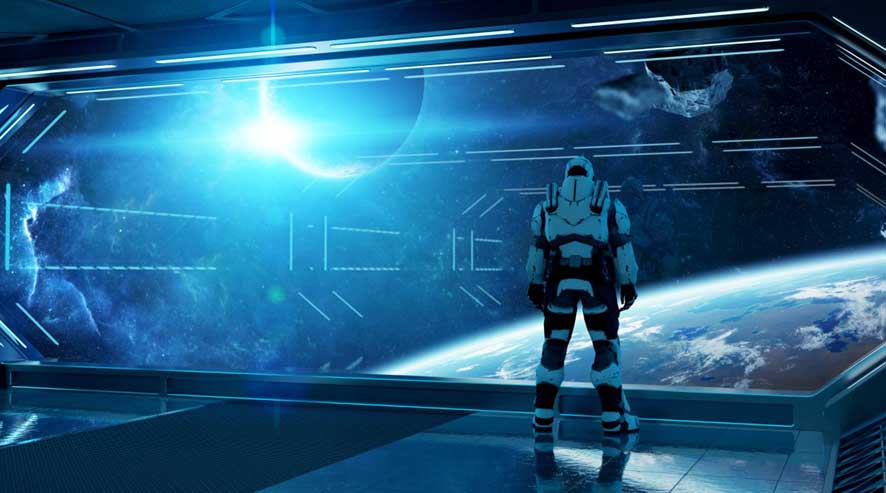The Disgruntled Worlds of Cyberpunk, Biopunk, General Dystopia, Apocalyptic, and Post-Apocalyptic Sci-Fi.
Cyberpunk, Biopunk, General Dystopia, Apocalyptic, and Post-Apocalyptic Sci-Fi. And there’s a lot more–Steampunk, Dieselpunk, Decopunk, and Nanopunk. What the heck? What are all these sub-genres of Science Fiction?
Here are the definitions of the “main” sub-genres: [Courtesy of Moira Allen at Writing-World.com]
Apocalyptic, holocaust, and post-apocalyptic science fiction focus on the end of the world, or the world just after “the end.” In Niven and Pournelle’s Lucifer’s Hammer, society is wiped out by a comet and must rebuild; in Nevil Shute’s On the Beach, humanity is destroyed by a nuclear holocaust; in Stephen King’s The Stand, humanity must cope with the aftermath of a devastating plague.
Cyberpunk is set in a high-tech, often bleak, mechanistic and futuristic universe of computers, hackers, and computer/human hybrids. The subgenre was pioneered by Bruce Sterling and William Gibson, who coined the term “cyberspace” in Neuromancer. Humans may have built-in computer jacks or software (“wetware”), and spend considerable time “living” in a virtual environment, as in The Matrix.
First Contact explores the initial meeting between humans and aliens, ranging from horrific tales of invasions to stories of benign visitors bearing the secrets of advanced technologies and world peace (or irony, as in The Twilight Zone episode “To Serve Man” — the one that ended, “It’s a cookbook!”). The meeting may occur on Earth, in space, or on another planet. H.G. Wells’ War of the Worlds helped define the “alien invasion” variant of this subgenre.
Hard Science Fiction is driven more by ideas than characterization. Plausible science and technology are central to the plot. If your story is set on a lunar colony, for example, issues of technology may be of greater concern than a character’s personal life. To write effectively in this subgenre, an author must generally have a good grasp of the scientific principles involved. Much classic science fiction, including the earlier works of Asimov and Heinlein, fall into this category.
Military Science Fiction looks at combat in future locations (space, another planet), against a range of opponents (modified humans, aliens, machines), with futuristic, high-tech weaponry (including genetically modified soldiers). While some military science fiction asks “how fast can we blast the bugs?” (Robert Heinlein’s Starship Troopers), many authors use this subgenre to address anti-war themes. David Drake’s Hammer’s Slammers series explores both the heroism and the carnage of warfare.
Science fantasy/future fantasy, rare now but popular in the 1930’s and 1940’s, alters, breaks, or ignores known laws or scientific theories for the sake of the story. Edgar Rice Burroughs’ Barsoom novels (set on Mars) are a good example.
Slipstream (or Speculative Fiction) deals with “mainstream” themes but contains a speculative element. Margaret Atwood’s The Handmaid’s Tale is set in a speculative future, for example, but is marketed as a mainstream novel.
Space opera, like Western “horse operas,” often involves good guys “shooting it up” with bad guys (who may be aliens, robots, or other humans) in the depths of space or on a distant planet. Space operas (of which Star Wars is a classic example) don’t worry about scientific implausibilities; technical explanations tend to be vague (“You see, Bob, if you fold space just so…”).
Time Travel was popularized by H.G. Wells with The Time Machine (1888), though Edward Page Mitchell wrote “The Clock that Went Backwards” seven years before that. Characters travel to the past or future, or are visited by travelers from either end of the spectrum. Topics range from “Let’s go see what the Pleistocene looked like,” to issues of paradox (what if you traveled to the past and killed your own grandfather?) and “tampering” (could stepping on a butterfly in the Paleolithic profoundly alter the entire future?). A variant of this subgenre is the “alternate universes” theme, in which each change in the timestream spins off a new universe.
Would you believe that there are even sub-genres of the cyberpunk sub-genre and derivative sub-genres? [From Wikipedia – Cyberpunk Derivatives]
Biopunk emerged during the 1990s and focuses on the near-future unintended consequences of the biotechnology revolution following the discovery of recombinant DNA. Biopunk fiction typically describes the struggles of individuals or groups, often the product of human experimentation, against a backdrop of totalitarian governments or megacorporations which misuse biotechnologies as means of social control or profiteering. Unlike cyberpunk, it builds not on information technology but on biorobotics and synthetic biology. As in postcyberpunk however, individuals are usually modified and enhanced not with cyberware, but by genetic manipulation of their chromosomes.
Nanopunk refers to an emerging subgenre of speculative science fiction still very much in its infancy in comparison to other genres like that of cyberpunk. The genre is similar to biopunk, but describes a world in which the use of biotechnology is limited or prohibited, and only nanites and nanotechnology is in wide use (while in biopunk bio- and nanotechnologies often coexist). Currently, the genre is more concerned with the artistic and physiological impact of nanotechnology, than of aspects of the technology itself.
Postcyberpunk. As new writers and artists began to experiment with cyberpunk ideas, new varieties of fiction emerged, sometimes addressing the criticisms leveled at the original cyberpunk stories. Lawrence Person wrote in an essay he posted to the Internet forum Slashdot in 1998: “Many writers who grew up reading in the 1980s are just now starting to have their stories and novels published. To them cyberpunk was not a revolution or alien philosophy invading science fiction, but rather just another flavor of science fiction. Like the writers of the 1970s and 80s who assimilated the New Wave’s classics and stylistic techniques without necessarily knowing or even caring about the manifestos and ideologies that birthed them, today’s new writers might very well have read Neuromancer back to back with Asimov’s Foundation, John Brunner’s Stand on Zanzibar, and Larry Niven’s Ringworld and seen not discontinuities but a continuum.”
Person’s essay advocates using the term postcyberpunk to label the new works such writers produce. In this view, typical postcyberpunk stories continue the focus on social implications within a post-third industrial-era society, such as a ubiquitous datasphere of computerized information and cybernetic augmentation of the human body, but not necessarily with the assumption of dystopia. It is rather characteristic for postcyberpunk to portray an utopia or to blend elements of both extremes into a more mature (to cyberpunk) societal vision.
Steampunk. The word “steampunk” was invented in 1987 as a jocular reference to some of the novels of Tim Powers, James P. Blaylock, and K. W. Jeter. When Gibson and Sterling entered the subgenre with their 1990 collaborative novel The Difference Engine the term was being used earnestly as well. Alan Moore’s and Kevin O’Neill’s 1999 The League of Extraordinary Gentlemen historical fantasy comic book series (and the subsequent 2003 film adaption) popularized the steampunk genre and helped propel it into mainstream fiction.
The most immediate form of steampunk subculture is the community of fans surrounding the genre. Others move beyond this, attempting to adopt a “steampunk” aesthetic through fashion, home decor and even music. This movement may also be (perhaps more accurately) described as “Neo-Victorianism”, which is the amalgamation of Victorian aesthetic principles with modern sensibilities and technologies.
Dieselpunk is a genre and art style based on the aesthetics popular between World War I and the end of World War II. The style combines the artistic and genre influences of the period (including pulp magazines, serial films, film noir, art deco, and wartime pin-ups) with retro-futuristic technology and postmodern sensibilities. First coined in 2001 as a marketing term by game designer Lewis Pollak to describe his role-playing game Children of the Sun, dieselpunk has grown to describe a distinct style of visual art, music, motion pictures, fiction, and engineering. Examples include the movies Iron Sky, Rocketeer, K-20: Legend of the Mask, Sky Captain and the World of Tomorrow and Dark City, and the games Crimson Skies, Greed Corp, Gatling Gears, BioShock, The Legend of Korra and Skullgirls.
So many types of science fiction, and most of it dystopian in some way. However, the best way to think of science fiction is that it is attempting to tackle big themes using the future (or possible ones) as its canvas.
What are some of the big themes being tackled in Liquid Cool? What’s next in Liquid Cool?
- The bigger technology becomes, the more vulnerable it becomes.
- No matter how much good technology does, its potential for evil will always be more.
- Technology: where the creator becomes the servant…or slave.
I really do like cyberpunk. In fact, even before I began writing Liquid Cool, the cyberpunk in me was seeping into my first published series, After Eden, with my Tek-Fall companion novels. The first episode was cyberpunk and robots; the second was cyberpunk and biopunk wrapped into one. More on my Tek-Fall Duology, another time.
How do I answer my own question? Will our own technology kill us all? Maybe. But I don’t think the culprit will be technology, rather human evil, or human apathy.
Get Your Free Copy of the Liquid Cool Prequel, These Mean Streets, Darkly Here Today.
Get Your Copy of the debut novel, Liquid Cool Here Today.

Austin Dragon is the author of over 30 books in science fiction, fantasy, and classic horror. His works include the sci-fi detective LIQUID COOL series, the epic fantasy FABLED QUEST CHRONICLES, the international futuristic epic AFTER EDEN Series, the classic SLEEPY HOLLOW HORRORS, and new military sci-fi PLANET TAMERS series. He is a native New Yorker but has called Los Angeles, California home for more than twenty years. Words to describe him, in no particular order: U.S. Army, English teacher, one-time resident of Paris, ex-political junkie, movie buff, Fortune 500 corporate recruiter, renaissance man, futurist, and dreamer.
LATEST RELEASE: THE OFFICIAL FABLED QUEST BESTIARY






0 Responses
nuclear technology could easily take us all out.
It may, but it won’t be because the technology itself is harmful it’s the hands controlling it that will be the determining factor.
I hope not!
That’s an amazing post ! I mean , why not ? We’re already halfway to destruction :/
Ray Guns don’t kill people, PEOPLE kill people. It won’t be the tech, but it could be the aliens that will finish us off.